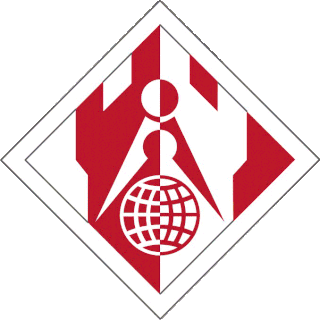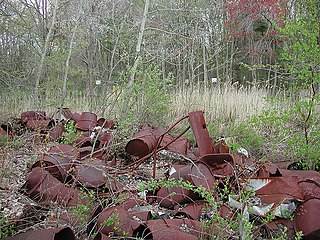Table of FUSRAP Sites
Data from multiple sources [1] [2] [3]

The Formerly Utilized Sites Remedial Action Program (FUSRAP) is a United States Army Corps of Engineers (USACE) project to manage and cleanup environmental contamination that resulted from early United States Atomic Energy Commission activities. Cleanup activities were initially performed under the supervision of the United States Department of Energy (DOE), until 1997 when the United States Congress passed authority for cleanup activities to the USACE.
The primary source of contamination at the locations stems from the processing of uranium ores and the disposal of the byproducts. The major sources of site contamination are uranium, thorium, and radium. In addition to the radiological contaminants there are semi-volatile organic compounds, volatile organic compounds, and heavy metals comingled at the sites.
Data from multiple sources [1] [2] [3]


The United States Army Corps of Engineers (USACE) is a direct reporting unit and engineer formation of the United States Army that has three primary mission areas: Engineer Regiment, military construction, and civil works. USACE has 37,000 civilian and military personnel, making it one of the world's largest public engineering, design, and construction management agencies. The USACE workforce is approximately 97% civilian, 3% active duty military. The civilian workforce is primarily located in the United States, Europe and in select Middle East office locations. Civilians do not function as active duty military and are not required to be in active war and combat zones, however volunteer opportunities do exist for civilians to do so.

Environmental remediation is the cleanup of hazardous substances dealing with the removal, treatment and containment of pollution or contaminants from environmental media such as soil, groundwater, sediment. Remediation may be required by regulations before development of land revitalization projects. Developers who agree to voluntary cleanup may be offered incentives under state or municipal programs like New York State's Brownfield Cleanup Program. If remediation is done by removal the waste materials are simply transported off-site for disposal at another location. The waste material can also be contained by physical barriers like slurry walls. The use of slurry walls is well-established in the construction industry. The application of (low) pressure grouting, used to mitigate soil liquefaction risks in San Francisco and other earthquake zones, has achieved mixed results in field tests to create barriers, and site-specific results depend upon many variable conditions that can greatly impact outcomes.

The Clean Water Act (CWA) is the primary federal law in the United States governing water pollution. Its objective is to restore and maintain the chemical, physical, and biological integrity of the nation's waters; recognizing the responsibilities of the states in addressing pollution and providing assistance to states to do so, including funding for publicly owned treatment works for the improvement of wastewater treatment; and maintaining the integrity of wetlands.

Cattaraugus Creek is a stream, approximately 68 miles (109 km) long, in western New York in the United States. The creek drains a wooded rural portion of western New York southwest of Buffalo into Lake Erie. In its lower course it flows primarily through the Cattaraugus Reservation of the Seneca tribe. William Beauchamp identifies the name Cattaraugus as deriving from the Seneca word Gah-ta-ra-ke-ras, meaning "stinking shore" or "foul-smelling river bank." This in turn is likely a loanword from an extinct Attiwandiron, Erie, Wenro, or Wendat (Huron) language, combining the verb root -i'tar-, referring to clay or mud, and -akera(n)-, describing a bad or strong odor: hence, tke'tarakeras, place of strong-smelling mud or clay. This name is a result of the natural gas that oozes from the river mud.

The Indiana Harbor and Ship Canal is an artificial waterway on the southwest shore of Lake Michigan, in East Chicago, Indiana, which connects the Grand Calumet River to Lake Michigan. It consists of two branch canals, the 1.25 miles (2.01 km) Lake George Branch and the 2 miles (3.2 km) long Grand Calumet River Branch which join to form the main Indiana Harbor Canal.

Camp Leach, formerly known as the American University Experimental Station and Camp American University, was a World War I era United States Army camp built by the Corps of Engineers on American University property in Washington, D.C. It was named in honor of Colonel Smith S. Leach, Corps of Engineers. The camp was established in 1917 for the organization of engineer units and subsequently used by the Chemical Warfare Service. Abandoned in January 1919, it was ordered salvaged.

Weldon Spring Ordnance Works (WSOW) was a 17,323-acre (70.10 km2) U.S. Government-owned, contractor-operated (GOCO) facility in St. Charles County, Missouri, 55 km west of St. Louis. The site was originally operated by the Atlas Powder Company during World War II from 1941 to 1945 to produce explosives. The Atomic Energy Commission acquired part of the property in 1955, and Mallinckrodt, Inc. processed uranium ore from 1957 to 1966 under contract. The site has been divided into several parcels, and ownership has transferred over the years. Two portions of the original WSOW property are now Superfund sites that require substantial cleanup efforts. The environmental remediation of the WSOW site is currently designated as a major project of the Defense Environmental Restoration Program of the United States Department of Defense. Part of the original property is still used by the Army Reserve as the Weldon Spring Training Area.

The former Lake Ontario Ordnance Works (LOOW) was a 7,500-acre (3,000 ha) military installation located in Niagara County, New York, United States, approximately 9.6 mi (15.4 km) north of Niagara Falls.
Soil vapor extraction (SVE) is a physical treatment process for in situ remediation of volatile contaminants in vadose zone (unsaturated) soils. SVE is based on mass transfer of contaminant from the solid (sorbed) and liquid phases into the gas phase, with subsequent collection of the gas phase contamination at extraction wells. Extracted contaminant mass in the gas phase is treated in aboveground systems. In essence, SVE is the vadose zone equivalent of the pump-and-treat technology for groundwater remediation. SVE is particularly amenable to contaminants with higher Henry’s Law constants, including various chlorinated solvents and hydrocarbons. SVE is a well-demonstrated, mature remediation technology and has been identified by the U.S. Environmental Protection Agency (EPA) as presumptive remedy.

Electrical resistance heating (ERH) is an intensive in situ environmental remediation method that uses the flow of alternating current electricity to heat soil and groundwater and evaporate contaminants. Electric current is passed through a targeted soil volume between subsurface electrode elements. The resistance to electrical flow that exists in the soil causes the formation of heat; resulting in an increase in temperature until the boiling point of water at depth is reached. After reaching this temperature, further energy input causes a phase change, forming steam and removing volatile contaminants. ERH is typically more cost effective when used for treating contaminant source areas.

The Church Rock uranium mill spill occurred in the U.S. state of New Mexico on July 16, 1979, when United Nuclear Corporation's tailings disposal pond at its uranium mill in Church Rock breached its dam. The accident remains the largest release of radioactive material in U.S. history, having released more radioactivity than the Three Mile Island accident four months earlier.

Uranium mining and the Navajo people began in 1944 in northeastern Arizona, northwestern New Mexico, and southeastern Utah.

The Uranium Mill Tailings Remedial Action (UMTRA) Project was created by the United States Department of Energy (DOE) to monitor the cleanup of uranium mill tailings, a by-product of the uranium concentration process that poses risks to the public health and environment. The Uranium Mill Tailings Radiation Control Act passed by Congress in 1978 gave the DOE the authority to regulate tailings disposal sites and shifted disposal practices to more engineered designs.
The Baytown Township Groundwater Plume is a Superfund site located east of the village of Lake Elmo, Minnesota, United States. The plume extends into Baytown and West Lakeland Townships and continues eastward approximately four miles to the St. Croix River. Baytown Township is a rapidly developing rural/suburban residential area on the eastern edge of the Minneapolis-St. Paul metropolitan area. The contaminated groundwater is primarily in the Prairie du Chien-Jordan aquifer, which is the major source of drinking water for many residents in the area through private and residential wells. The Lake Elmo Airport is located near the western end of the plume and is administered by the Metropolitan Airports Commission (MAC). An estimated 8,000 people live in the area; 80 percent of the residents use private wells for their water supply.

Shpack Landfill is a hazardous waste site in Norton, Massachusetts. After assessment by the United States Environmental Protection Agency (EPA) it was added to the National Priorities List in October 1986 for long-term remedial action. The site cleanup is directed by the federal Superfund program. The Superfund site covers 9.4 acres, mostly within Norton, with 3.4 acres in the adjoining city of Attleboro. The Norton site was operated as a landfill dump accepting domestic and industrial wastes, including low-level radioactive waste, between 1946 and 1965. The source of most of the radioactive waste, consisting of uranium and radium, was Metals and Controls Inc. which made enriched uranium fuel elements for the U.S. Navy under contract with the U.S. Atomic Energy Commission. Metals and Controls merged with Texas Instruments in 1959. The Shpack landfill operation was shut down by a court order in 1965.

West Lake Landfill is a closed, unlined mixed-waste landfill located in Bridgeton, Missouri. It was featured in the 2015 documentaries The First Secret City, The Safe Side of the Fence and the 2017 HBO documentary Atomic Homefront. Its contents have been shown to include radioactive waste; it is thus also an EPA Superfund cleanup site.
The Nebraska Ordnance Plant is a former United States Army ammunition plant located approximately ½ mile south of Mead, Nebraska and 30 miles west of Omaha, Nebraska in Saunders County. It originally extended across 17,250 acres (69.8 km2) producing weapons from 1942-45 after which the Army used it as a bomb factory during the Vietnam War. Environmental investigations in the 1980's found the soil and groundwater contaminated with the explosive RDX and the degreaser trichloroethylene. In 1990, federal agencies added the site to the National Priorities List as a Superfund site. Remediation included soil excavation and water treatment, the latter of which has been ongoing since 1997. Water is contained and treated at 4 treatment plants and the known plumes are monitored at hundreds of wells. The latest wells, dug deeper into the bedrock than previously, showed RDX and TCE above desired action levels in April 2016.
The Maywood Chemical Company processed radioactive thorium waste from 1916 through 1955 in Maywood / Rochelle Park, in Bergen County, New Jersey, United States. The United States Environmental Protection Agency (EPA) deemed Maywood Chemical a Superfund site in 1983 and has since been in the clean process.

The Sharonville Engineer Depot was a facility constructed by the United States Army near Sharonville in Hamilton County, Ohio, United States, for the purpose of storage of strategic metals. The site was originally 642 acres in size.